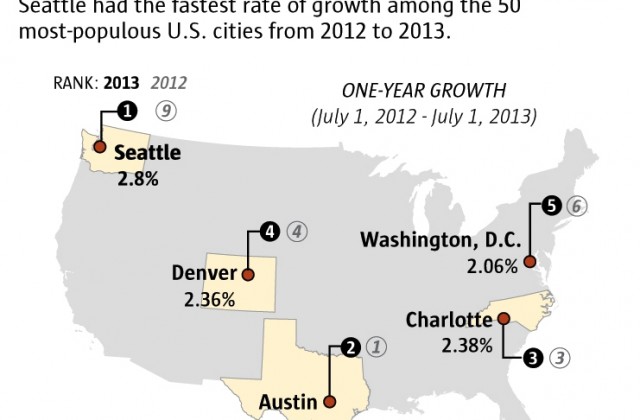The 652,000th Man: Seattle Tops Growth Chart
If the now retired and apparently found Casey Kasem did a top 40 for growing cities Seattle would be on the chart, holding the number one spot for the fastest growing city and the number 21 spot for overall population size. A Seattle Times blog post yesterday caught a lot of people’s attention, including me; I said in public comments at the microhousing hearing Monday that we ought to be more focused on how we house the thousands of people moving to Seattle rather than obsessing about where they wash their hands. I know I am annoying Councilmembers with my sink routine, but yesterday’s blog post only highlights how important increased housing option and choice will be in the years ahead.
What’s the reason for Seattle’s population boom? The Census Bureau offers no interpretation of its data, but surely the city’s healthy economy is responsible for attracting many new residents. According to Seattle’s Office of Economic Development, the city added nearly 15,000 new jobs between 2012 and 2013.
Seattle didn’t just surpass other big U.S. cities in 2013. For the second consecutive year, it outpaced its suburbs — and the new census data show this trend is accelerating.
Seattle grew at double the rate of surrounding King County between 2012 and 2013. That is significantly faster than in the previous year’s census estimates, which clocked Seattle’s growth at 25 percent faster than its King County suburbs.
I told Councilmember Sally Clark in a meeting yesterday morning about microhousing, that every concession the Council makes to neighbors angry about change and new growth makes it harder on all these new people moving to our city, costing them units of housing. The math is pretty simple, and a colleague point out that based on the Census numbers in the Times, the figures I quoted at the microhousing hearing were underestimating growth.
One thing I would challenge though is the growth projection of 120,000 by 2035. The census shows we added 18,000 people in the last year alone. 18,000 x 20 years = 360,000 people.Amazon’s 3 new towers alone are adding 15,000 new jobs. Add a jobs multiplier and a population multiplier to that, and we’re talking maybe something like 45,000 new people as a result of those new jobs just from that one new expansion of Amazon.
Now we can either spend our time resenting and lamenting new growth or we can plan for it and welcome it. Unfortunately the Council slashed single-family infill growth with a massive downzone on Monday. As we analyze microhousing legislation it’s easy to see that it is filled with added requirements, costs, and takeaways. And the Council is considering increases to the so-called “incentive zoning” fee.
Taken together I’d argue that the Council is squeezing down on housing and supply and choice, handing out the eliminated units from their new rules, regulations, and fees like candy to angry neighbors who are defending the status quo. I know that this criticism is upsetting to Councilmembers but it is valid.
The numbers are right in front of us. Why are we having to fight for hundreds of single-family lots, additional microhousing, and increased density in neighborhoods with the greatest capacity for new people? We must continue to make the case that we need more housing, of all kinds everywhere in the city, not less. Even saying that might make some Councilmembers and and angry neighbors uncomfortable today, but if someone doesn’t stand up for growth, life will be miserable for thousands later.


